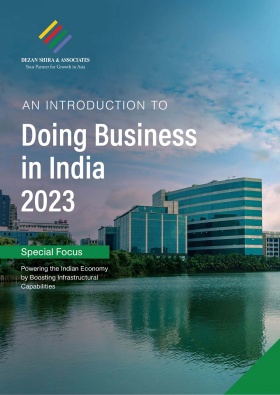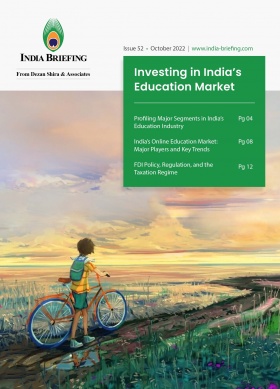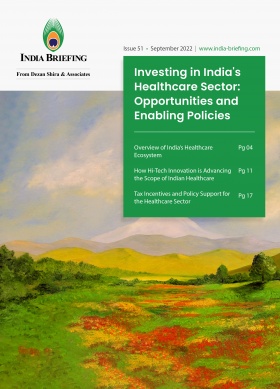India to Surpass China’s Population in 2023: Here’s Why That Matters
In 2023, India will surpass China to become the world’s most populous nation. The milestone is symbolic, providing the nation with a unique opportunity. With a high proportion of working-age citizens to dependents, India will remain a relative bright spot amid a slowing global economy.
The world will witness a symbolic demographic event in 2023, as India becomes the world’s most populous nation. According to the United Nations, India’s population will exceed that of China’s in April. The milestone isn’t significant in itself, but highlights the variance in demographic patterns between the world’s most populous two nations.
China, largely by virtue of its size, has been the world’s most populous nation – excluding empires – for three centuries. In the latter half of the 20th century, China’s population, like those in many developing countries, surged. But the introduction of the one-child policy in 1980 drastically changed the trajectory of China’s population growth.
Conversely, the rate of India’s population growth has remained strong, growing from 446 million in 1960, to 1.06 billion in 2000, to 1.407 billion in 2021. The population is expected to peak at 1.7 billion in 2064, when it will be nearly 50 percent larger than that of China. This population expansion has been reflected in the growth of India’s economy, recently displacing the UK as the world’s fifth-biggest largest economy.
The State Bank of India predicts that India will be the world’s third largest economy in 2029, propelled by a huge working-age population. There are other factors at play in India’s economic growth, including shifting manufacturing patterns as firms turn away from China and invest more in secondary destinations, including the world’s largest democratic state. However, India is also facing several challenges that could prevent it from fully benefitting from its “demographic dividend”.
So, what should we be looking out for in 2023?
China vs India: Trends
China’s self-imposed demographic slowdown, dubbed the “4-2-1 phenomenon”, presents several challenges. The term reflects the notion that, because of the one-child policy and generally low rates of reproduction, each only child has two parents and four grandparents, for which they are, in a more generalized sense, economically responsible.
The shrinking size of the working-age population coupled with the increasing size of its dependent population presents a huge challenge for the state. China’s average age in 2021 was 38.4 – that’s greater than the US at 38.1. It is unclear whether China’s working age population will be able or willing to afford the demographic burden. The state’s public pension system, which many elderly people will be forced to rely on, itself is underfunded.
This impact’s India in more ways than one. But chief among them is an end to China’s abundant and low-cost labor – the state is already experiencing shortages of manual labor and unskilled workers – and this incentivizes divestment into countries like India. India has more people of working age than any other population group, leading to what is a demographic dividend.
Evidence suggests that India is already benefitting from a shift in production away from China, due to the aforementioned abundance of labor, and concerns about Beijing’s control over policy direction as well as an uncertain geopolitical backdrop.
Can India collect its demographic dividend?
A demographic dividend is said to occur when the ratio of the working-age population is high and the dependency ratio with regards children and elderly people is low. There are several reasons this is deemed as a positive. Firstly, it creates an economic surplus and allows for reinvestment by the state. But the abundance of labor also attracts investment.
Data suggests that India could have a golden period between 2020 to 2040, if the demographic dividend is harnessed properly. This is the period during which the working-age ratio will peak. “Harnessing” is the key word here. India needs a healthy, educated, skilled, and willing economically active population.
This is where the state faces challenges. Around 90 percent of jobs in India are informal, meaning most of the population don’t have a regular salary – this can be particularly damaging when economic shocks, like that caused by Covid-19, take place.
Meanwhile, just 20 percent of women of working age are indeed working, reflecting concerns around the implementable skills within their education. Men, from the same education background, find it easier to get work in labor-intensive sectors, such as truck driving, electronic repair, or postal delivery workers.
Evidence also suggests that only around three percent of the workforce have formal training of any kind. This compounds widespread issues around health, including malnutrition and anemia, which means many people entering the workforce may have had impairments in their cognitive and physical development.
Foreign investment is also key to harnessing this demographic dividend. The government has pushed forward with its ‘Make in India’ initiative, which has seen some success. This includes Apple’s moves away from China to India. It was reported last week that Apple exported more than US$2.5 billion of iPhones from India in the months from April to December, nearly twice the previous fiscal year’s total.
In 2023, we can expect the central government to place increasing emphasis on addressing these factors impeding India from collecting its demographic dividend.
A “bright spot” for the global economy in 2023
Amid slowing economic growth globally, India remains a relative “bright spot” in the world, according to an International Monetary Fund official, speaking last week. Despite various challenges, it is expected to remain the second-fastest growing nation – lagging only behind Saudi Arabia – among G20 countries, with the economy growing at seven percent in 2022/2023. Construction growth was projected at 9.1 percent, electricity at nine percent and agriculture at 3.5 percent. Manufacturing and mining growth were forecast at 1.6 percent and 2.4 percent respectively.
Manufacturing
While the manufacturing sector is growing slower than other parts of the economy, it is worth highlighting that the government is making a concerted effort to increase manufacturing activity within the country. Manufacturing generates 14 percent of Indian GDP, compared with 27 percent in China.
The state has been pushing ahead with initiatives to enhance employability and reduce imports. Some of the initiatives are structural in nature, like land and labor reforms – these take time to bear results. But other efforts are already bearing fruit, such as the Production Linked Incentive (PLI) Scheme rolled out to attract companies in key sectors, including IT hardware and automotive production.
These initiatives from New Delhi will likely be enhanced by the “China + 1” strategy. This is where companies avoid being solely reliant on production facilities in China and therefore divest and diversify their businesses towards other countries. India, offering cheap and abundant labor, is among those to benefit.
Foreign direct investment (FDI) into Indian manufacturing will likely continue to tick upwards in 2023 despite near-term demand challenges and the relative strength of the rupee against sterling, the euro, and the Japanese yen. This reflects longer-term trends towards utilizing India’s vast market and low-cost labor force and reducing exposure to China.
Retail and domestic consumption
Strong domestic consumption will likely be the main driving force behind economic growth in 2023 – this will also mitigate the impact of slowing global demand. And this is important, as the domestic economy is also driving formalization and is enhancing trends like e-commerce adoption.
The Boston Consulting Group (BCG) expects the Indian retail industry to grow at 9-10 percent each year over the course of the next decade and will be worth a staggering US$2 trillion by 2032. Consumption was growing at approximately 10-12 percent in the decade to 2019, driven by socio-economic developments and an enabling environment, characterized partially by the growth of e-commerce platforms. Internet adoption during the pandemic provided an extra boost to e-commerce development.
Low-carbon industries and energy generation
Amid rising global energy prices, and India’s reliance on fuel imports, there will likely be renewed emphasis on low-carbon energy generation in 2023. The government is expected to unveil new hydrogen and carbon market policies in 2023 to drive investment and set out a decarbonization future.
India has the potential to create 287 gigatons of carbon space for the world – a figure that amounts to half of the global carbon budget required to limit warming to 1.5°C. According to reports, India may attract investments worth US$10 billion in the low-carbon energy segment this year. However, this is just a fraction of the financing needed to hit carbon-zero objectives – India aims to be carbon-neutral by 2070. McKinsey anticipates that US$7.2 trillion of green investments is required under the current line of sight scenario in the years to 2050.
Reports suggest that a national carbon market will likely be launched within the year. Iron and steel, cement, refineries, and fertilizer producers are among sectors that will be assigned emission quotas. These industries will be obliged to trade carbon credits on India’s power exchanges, according to government officials.
Energy infrastructure investments will also contribute to the growth of the construction sector in India. The industry is expected to grow at an annual average growth of 6.2 percent from 2023 to 2026.
About Us
India Briefing is produced by Dezan Shira & Associates. The firm assists foreign investors throughout Asia from offices across the world, including in Delhi and Mumbai. Readers may write to india@dezshira.com for more support on doing business in in India.
We also maintain offices or have alliance partners assisting foreign investors in Indonesia, Singapore, Vietnam, Philippines, Malaysia, Thailand, Italy, Germany, and the United States, in addition to practices in Bangladesh and Russia.
- Previous Article India’s Leading Export Destinations: Trends and 2023 Outlook
- Next Article India-Australia ECTA in Force from December 29, 2022: Key Benefits









